Around the World in 60 Days
I completed the short flight from Bangkok to Paro, Bhutan around 1:00 p.m. on the afternoon of July 9th. After an easy trip through customs and baggage claim, I came out of the arrivals doors to find a man holding a pink sign- Kathie Redman- closer than Vietnam! Another guy took my bag, and the three of us headed to a navy blue Toyota Land Cruiser which would be my home for the next 5 days. Once we got settled, I was introduced to Tandin and Tenzin, who would be my companions in Bhutan. The first order of business was for me to learn their names, which was harder than it sounds, without seeing them written down. At first, I was confused as to why there were two people picking me up, but I eventually figured out
katieredman14
8 chapters
Bhutan
Bhutan
I completed the short flight from Bangkok to Paro, Bhutan around 1:00 p.m. on the afternoon of July 9th. After an easy trip through customs and baggage claim, I came out of the arrivals doors to find a man holding a pink sign- Kathie Redman- closer than Vietnam! Another guy took my bag, and the three of us headed to a navy blue Toyota Land Cruiser which would be my home for the next 5 days. Once we got settled, I was introduced to Tandin and Tenzin, who would be my companions in Bhutan. The first order of business was for me to learn their names, which was harder than it sounds, without seeing them written down. At first, I was confused as to why there were two people picking me up, but I eventually figured out

that each group traveling to Bhutan, whether 1 person or 10, has a guide and a driver assigned to them. Tandin was my guide, and spoke better English than I had heard from a local so far in my travels. As we drove, he introduced me to the history of the country and various landmarks that we passed. Tenzin was my driver and could also speak English, though he spoke less frequently. The two of them sat in the front while I sat in the back to look at the scenery and listen to Tandin.
The country we were driving through was spectacular. We were driving down a long valley from the Paro airport to Thimphu, the capital. There were huge bluffs rising up on either side of the river, and they are a very healthy green color in July, during the monsoon season. There were trees and grass rising up all the way to the tops of the bluffs on either side. The road was new a few years ago, and ran maybe an eighth of the way up the bluff from the river. There were cows wandering wherever they pleased, and several had chosen to sit on the road while they chewed the cud. There was also a large population of dogs running rampant in both country and city. Most don't belong to anyone and roam where they please. While we were driving, Tandin gave me a brief history of Bhutan, which was very useful information for the rest of the trip. The country dates back to the 8th century, when a saint from Nepal brought Buddhism into Bhutan. Their history then blacks out until the 17th century, when another saint united the whole country and set up a system in which

the Monastic Body and the Administrative body worked together. The next big landmark was 1906, when the first dynasty was established. Their fifth king was just crowned in 2006, at the age of 35. The people love the royal family, and hardly recognize any other celebrities, whether they are US actors, English soccer players, or Bhutanese pop stars. We had a minor run-in with the royal family during their first drive of the trip. We had stopped at the confluence of two rivers and were passed by a procession of flag cars and members of the royal family! Tandin told me that he knew one of the men in the royal cars- his friend had married one of the princesses. I guess an encounter like that isn't so strange in a country with 700,000 people, but I was impressed.
Once we arrived in Thimphu, the sight-seeing began in earnest. The first stop was the National Memorial Chorten, which is a large stupa in the middle of Thimphu. A stupa is a sort of tower that can be any
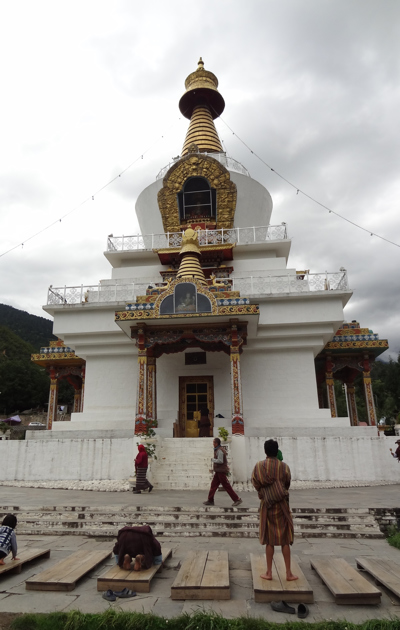
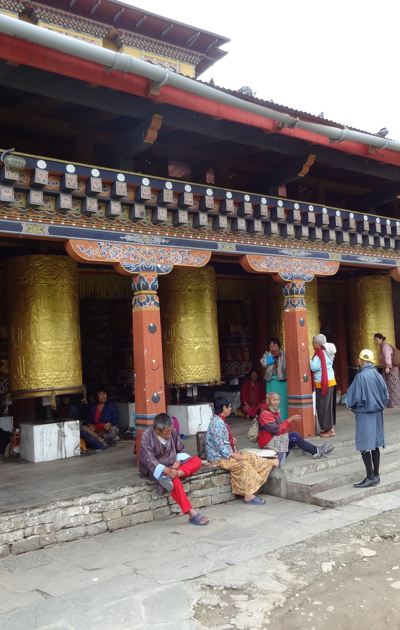
size- from three inch stupas made of the ashes of a relative, to tall buildings, like the National Memorial Chorten, which holds a temple inside. Stupas are said to be protective and ward away evil spirits. Some also dedicated to various causes, like world peace or the longevity of a king. Tandin walked me around the monument, explaining more about the various saints and deities in Bhutan. He also started to fill in my (very) spotty knowledge of Buddhism. It was at this temple that we first encountered prayer wheels. These are basically a cylinder that has a prayer written on the inside. The larger the prayer wheel, the more times the prayer is copied inside. The wheels are spun in the clockwise direction, which spins the prayer and sends it heavenward. The more times the wheel is spun, the more prayers are said, which is good karma. Small prayer wheels can be held in the hand, but the wheels at this monument were maybe 5-6 feet tall and very heavy to spin. Other wheels are placed over a stream and have a propeller that spins the wheel as water flows past. We spun the prayer wheels at the monument, weaving around the elderly people who gathered there to walk, pray, and socialize. We then took a quick walk around the monument and headed to the next stop.
Next, we went to the GIGANTIC Buddha statue on the bluff above Thimphu. Tandin wasn't sure if it was the largest in the world, but I bet it's close. It's temple in the interior is still under construction, but they are almost done with the exterior, which I admired for a while before heading off to what Tandin called the national "zoo". It is more of a pasture than a zoo and is home to a small herd (~30) of the national animal, the Takin. This member of the "goat antelope family" is so ugly you can't help but like it. The younger ones look like large goats, and are a dark gray/brown color. As they grow, the males develop a unique hair style that may have inspired the "frosted tips" look rocked by N'Sync in the 90's. Apart from their color, they are a large, docile-looking animal about the size of a cow. Good choice for a
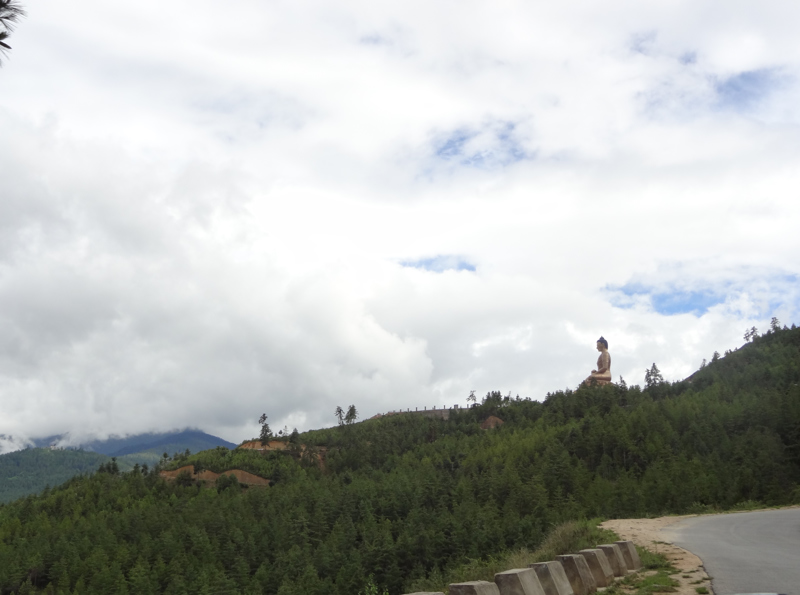
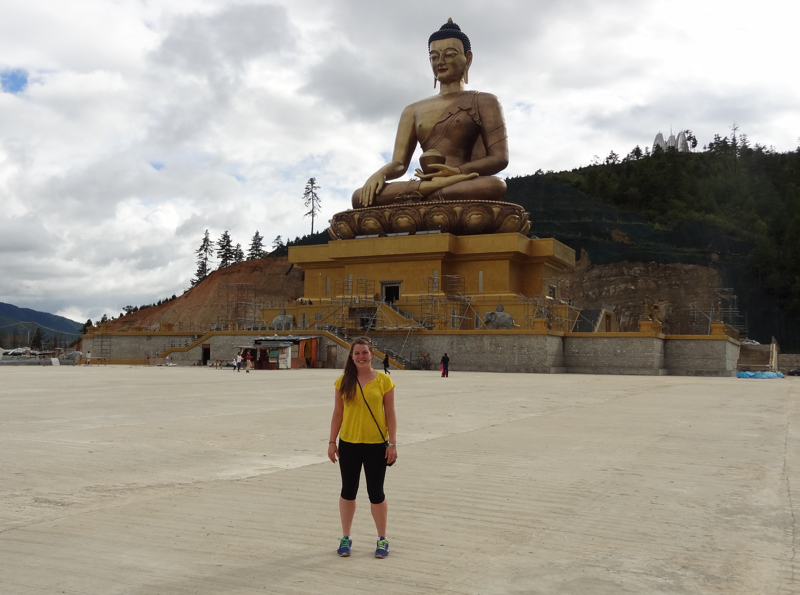
national animal, if you ask me. Our last stop of the day was at Tashichhodzong, the large dzong in the center of Thimphu. Dzongs were originally fortresses used in defense, but have since become temples and home to administrative functions of their government. Instead of a separation between church and state, the monastic body works hand in hand with the Bhutanese monarchy and elected officials to manage the country. Tandin explained some of the paintings and statues and we visited the temple, which is where royal coronation ceremonies take place.
The hotel for the first two nights was located across the river from the center of Thimphu. This strategic location gave it a nice view of town while keeping a distance from the dogs that barked all night long. I went straight to dinner, and had my first of many "tourist-style" meals. There is a set menu of 6-7 dishes, and they bring you every
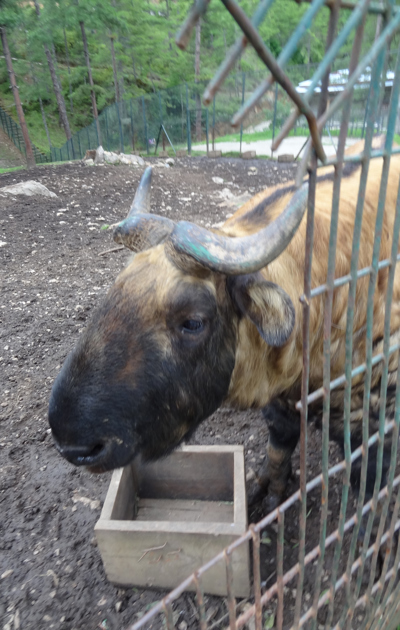
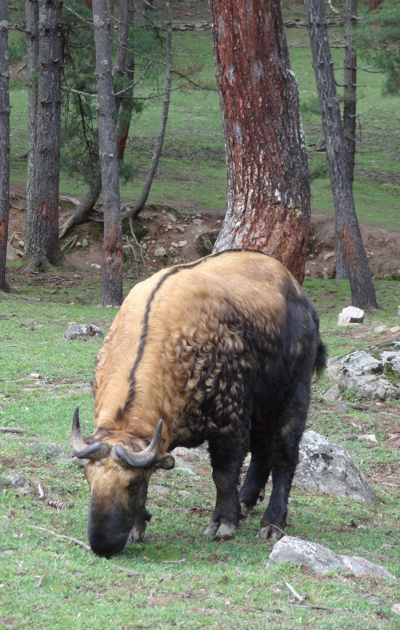
single one of them. I never finished more than half of the food that they brought me, but I couldn't convince them to bring less. There were things like mixed vegetables, roast chicken, chow mien, etc. Almost all of the tourist meals I ate were cooked well, but lacked any authentic Bhutanese flavors. I ate my dinner alone in the hotel, with about 4 waiters watching over me. Apparently July is a very low season for tourism in Bhutan, and I found that I was the only diner at most of the places I ate. After dinner, I wanted to go in and explore Thimphu, which is the largest city in Bhutan with about 100,000 people. As I walked along the main street in town, I was struck by the lack of tourists. It was also interesting to see the mix of traditional and casual dress among the locals. Traditionally, Bhutanese men where a "goh", which is basically a knee-length bathrobe with long sleeves. The women where a "kira", which is a full-length skirt or dress, covered with a jacket and pinned with a broach. People wearing these outfits mingled with those in casual, western dress. I

strolled along, looking at the people and the shops, then came home around 9:00 p.m. and going to bed early to make up for the night before.
The next day, July 10th, I ate an American breakfast in the hotel and chatted with one of the waiters. I learned about the popularity of soccer in Bhutan and the various high-profile games that had been played recently. Tandin and Tenzin then picked me up, and went to check out the weekend market that was just starting up. It was almost exclusively a food market, and I saw many foods that I had already seen around Southeast Asia. There were some new things, however, like piles and piles of dried fish. Buddhists do not believe in killing, and that extends to fish. As such, fishing is very limited in Bhutan and this how their fish from India. There were also a couple of new vegetables with unfamiliar names, which Tandin described to me. I thought the grain section of the market was most interesting. Bhutan specializes in red rice, which looks like red wheat and has a taste somewhere between white and brown rice. They also prefer salty to sweet snacks, and have variations of rice crispies and corn flakes that they mix into their tea. Also at the market were stands selling incense and bitter nut, which is (I think) a mild recreational drug. The nuts are the size of chestnuts and are dipped in lime and wrapped in a leaf. They are then eaten a quarter or a half at a time, and leave the person's teeth bright red for a while afterward. Bitter nut is very popular among both men and women in Bhutan.
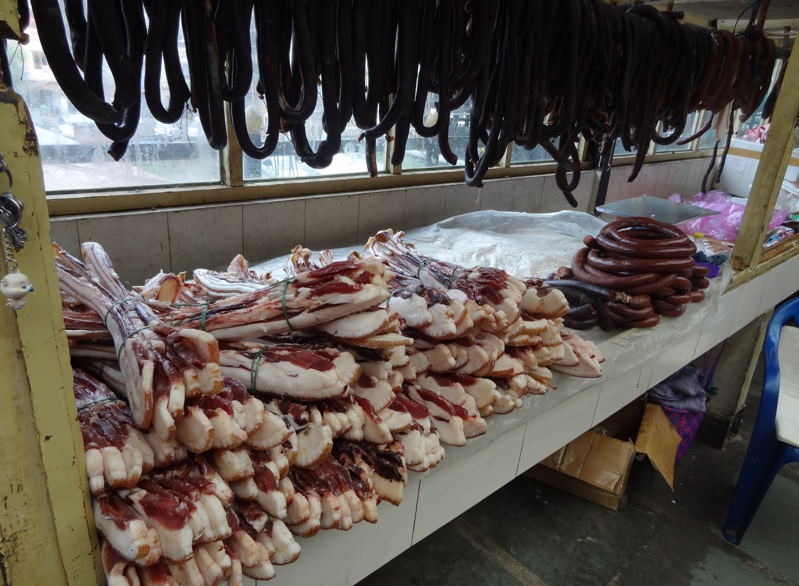
After the weekend market, we drove by the archery field where we found 10-20 men practicing. Archery is practiced almost exclusively by men and many fields require them to be in traditional dress. The targets are 150 meters away and each man shoots two arrows before walking down to the other end and shoot in the other direction. It's amazing that they can shoot that far with both modern compound bows and the traditional Bhutanese bows. Our next stop was the Folk Heritage Museum, which is an old house set up as the Bhutanese used to live. The ground floor was open and had a small stable for valuable livestock. The next floor was a store room for grain, food, wool, etc. The third floor has the living quarters, which includes a wood stove in the kitchen with a very small chimney. There was also a living room where the family lived and slept and an alter room, which is bigger than the other rooms and beautifully decorated. After the Folk Heritage Museum, we went to the National Library. Libraries are not common in Bhutan and Thimphu is the only city with its own library. There are two buildings- one for books in English and another for books in dzongka, their national language. We went into the latter, which is full of religious books with prayers, mantras, etc. In these books, the pieces of paper are not bound together, but are in a loose stack. They are stored in a box that is then tied shut with colorful ribbon. The shelves were full of these very colorful books. Bhutan is also home to the world's largest book, a picture book of Bhutan, which is 5 feet tall and on display under glass.
After the library, we visited the Textile weaving center. Bhutan has some very intricate weaving techniques, some of which are often mistaken for embroidery. They also weave with all kinds of material, from raw silk, to yak's hair, to nettles which have been soaked. They use raw silk to avoid killing the caterpillar that is inside the cocoon
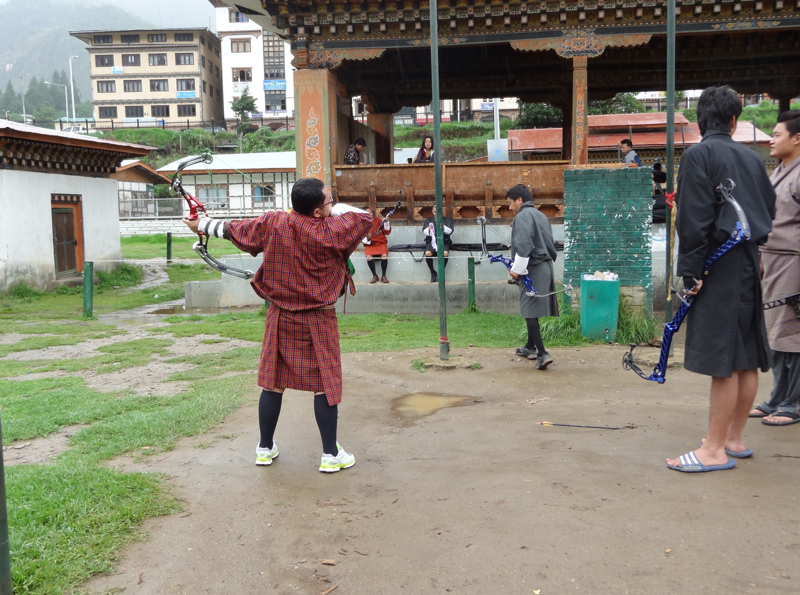
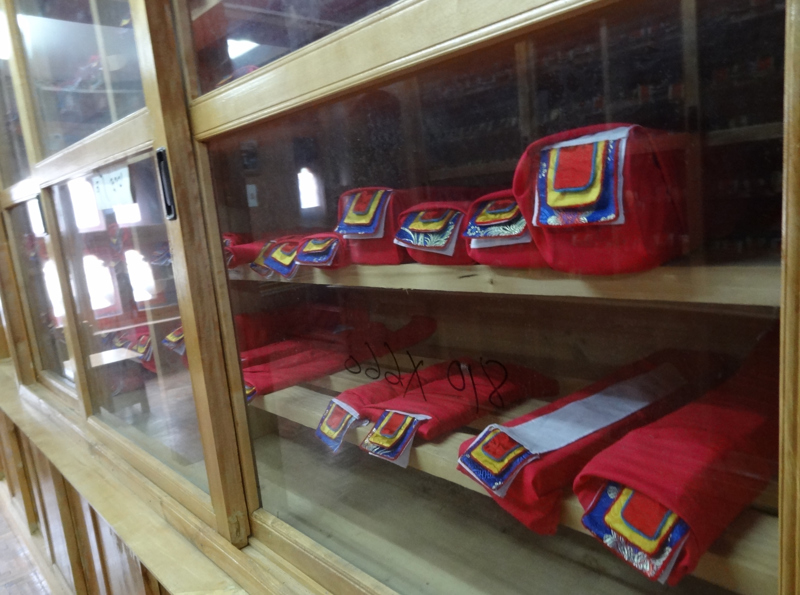
used for fine silk. The Textile center included the wedding clothes of the last king, who married four sisters simultaneously in the 1970's. This building lets out right into the Crafts Bazaar, which consists of about 100 wooden sheds full of crafts and souvenirs. It was much nicer than shopping in the other Southeast Asian countries, where you are bombarded by the shop owners. The Bhutanese let me shop around with or without buying something, which I really appreciated. I bought several things, including my own kira skirt and belt! The nice lady who sold it to me helped me put it on, then lent me a jacket and took my picture in full traditional dress. Around then, Tenzin got bored sitting in the car and walked with me for the last 30 shops or so, helping me pick out a belt, Christmas ornaments, and a
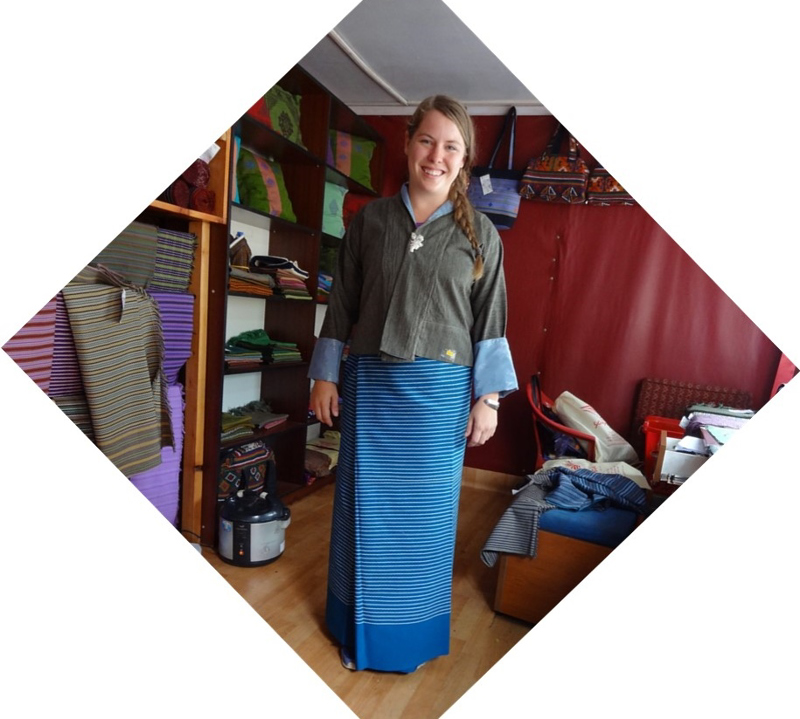
Bhutanese friendship bracelet. I had spent most of my money by the time I got to the end of the line of shop and was ready to head to lunch.
After a nondescript tourist lunch, we set off for a day hike outside of Thimphu. We had traveled about 8 miles out of town and were headed up a hill when we heard a funny noise coming from the engine compartment. We pulled over and Tenzin started pulling out pieces of the power steering belt. We were stuck and decided that Tenzin would stay with the car to wait for the mechanics and Tandin and I would walk back toward town. It was a really nice walk. We talked about differences between Bhutan and the US, and a little about our backgrounds. We walked along the river for a while then ended in downtown Thimphu, where he left me around 5:00 p.m. I had asked to find my own dinner that night, so I looked around for possible spots before heading back to the hotel. I bought a beer and enjoyed the view from my balcony until it got dark. Around 7 or 8, I went back into town and started prowling around for a dinner spot. I finally settled on something that fell between Bhutanese and Tourist food. The Bhutanese have a love for hot peppers that most westerners cannot tolerate, and I didn't feel brave enough to try something truly local. The food was good, and I even tried some butter tea, which is popular in rural areas of Bhutan. It is exactly what it sounds like- butter stirred into tea- and tastes a lot like melted butter. After that, I headed home to shower and pack. The next day we were leaving for Punakha, a three hour drive over a
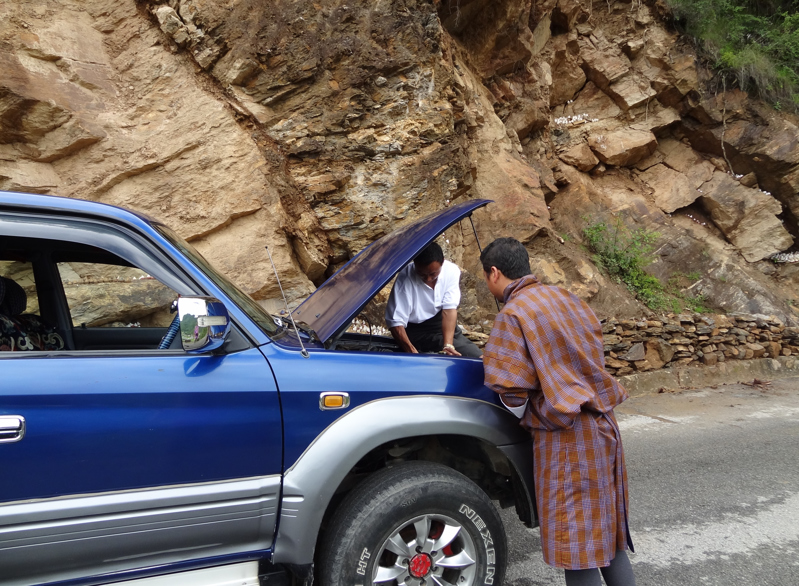
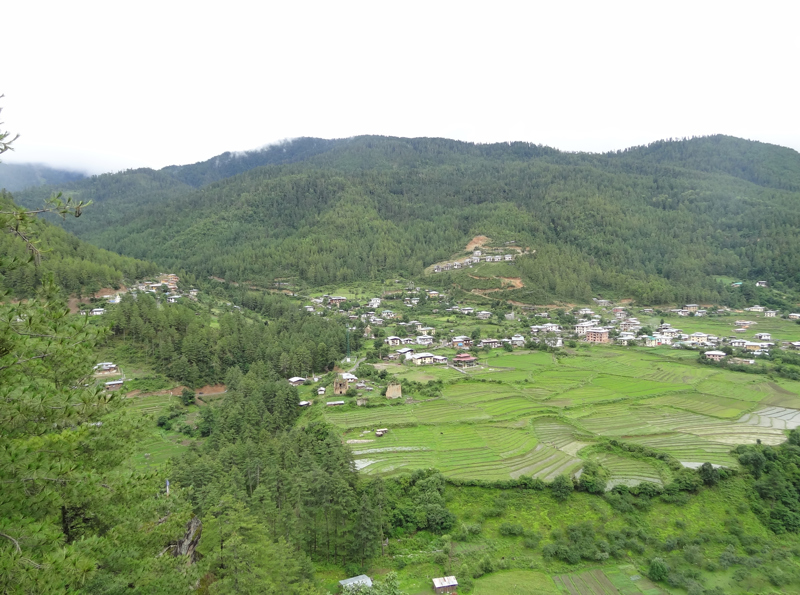
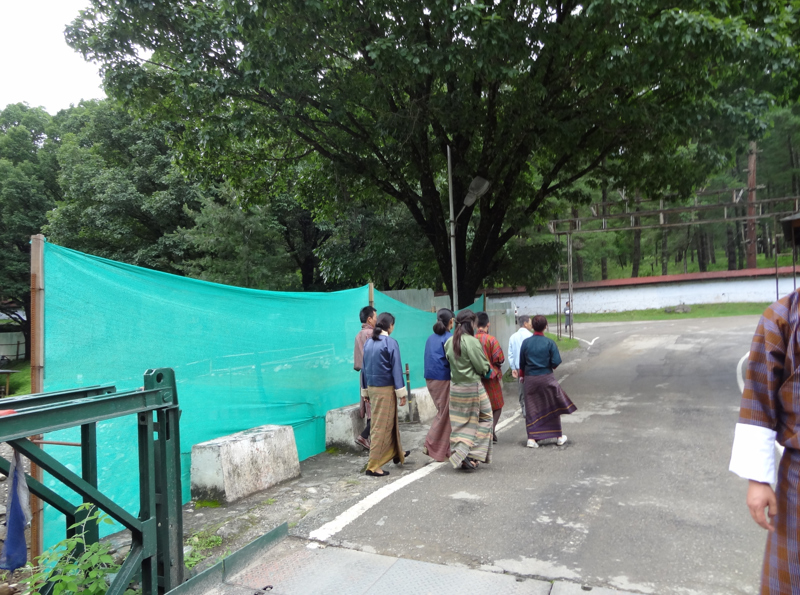
mountain pass.
The third day, July 11, I tried an Indian-style breakfast and chatted some more with the waiter. At 8:00 a.m. sharp, we set off for Punakha. Today's road was much different from the new, modern roads between Thimphu. The road over Dochula pass had undergone a widening project during the past three years, and they just recently finished the excavation. This was good news, but the road had not yet been paved and recent rains had washed out the mountain above and below the road. Tenzin had his hands full to avoid the construction trucks, cows, dogs, and people going both directions on the bumpy, narrow road. He handled it like a pro though, and there were only a couple of times that I had to cover my eyes and hold my breath. All in all, I thought the ride was a lot more fun this way. We talked a little as we drove- I found out that Tandin had a brand new baby boy and a 3 year old girl and that Tenzin has two dogs. Tandin also commented on the trees and wildlife we were passing. He is an expert on the flora and fauna of Bhutan, and his English vocabulary in this area is better than mine.
The Dochula Pass offers an awe-inspiring 180 degree view of the Himalayas....during the winter. In the summers, it offers a very nice view of the clouds, with an occasional mountain peaking over the top. Apart from the mountains, the four queen mothers built a monument here for their husband, the fourth king of Bhutan. There are 108 stupas arranged in a concentric circles, adjacent to a hill covered in prayer flags. Prayer flags come in a couple different forms, and are generally placed either high up on a mountain or on bridges. Both of these places allow plenty of wind to blow through the flags and take the prayers up to heaven. Some prayer flags are dedicated to dead people and have prayers for them written on the fabric. Other flags are inscribed with prayers for good luck and are either all white or rainbow-colored. Each of this kind of flag is about 12" x 12" and strung together with other flags to be stretched between two trees/ poles/ etc. Bhutan is absolutely covered in these prayer flags, which add some color to the green hillsides. The first part of the descent was not very eventful, but after we cleared the cloud level we could see the beautiful Lobesa valley where Punakha is located. The valley is a beautiful patchwork of fields, ranging from the bright green of newly planted rice paddies to the darker greens of grass and trees. The elevation is much lower here, meaning that the mountains on either side of the valley rose up higher than those near Thimphu. The lower elevation also meant higher temperatures- it was a bright, sun-shiny 80 degrees when we were there. As we descended, Tandin
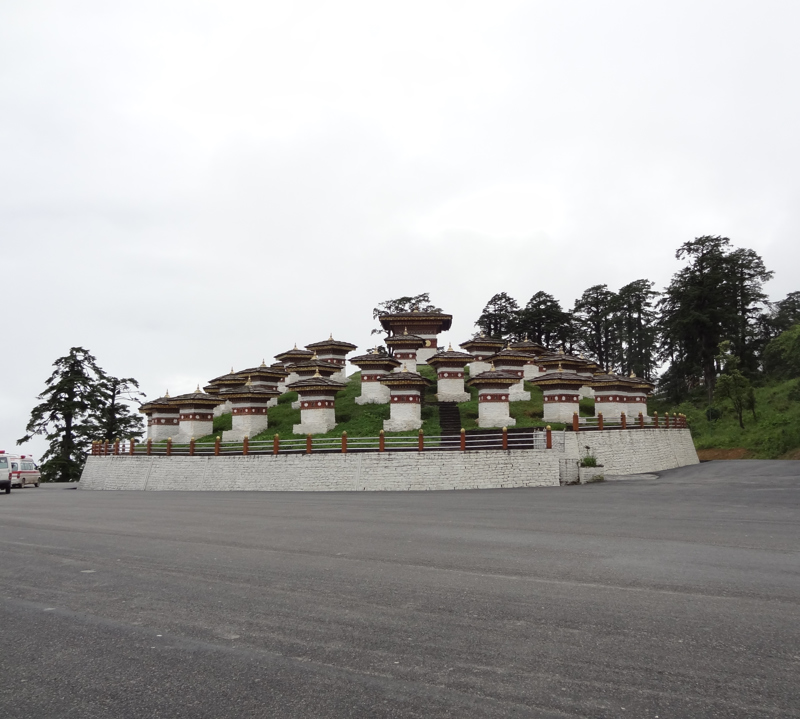
and Tenzin spoke back and forth in Dzongka. It was nice background noise that was made cheerful by Tenzin's frequent laughs and smiles. I didn't know what he was laughing about, but it was definitely cheerful!
Our first stop at the bottom of the valley was Chimmi lhakang, a temple dedicated to the Divine Madman. This is probably the most interesting saint in Bhutan's spiritual history. Instead of following the rules of Buddhism that frown on things like public nudity and playboys, he embraced them to show that cultural norms do not dictate good vs. bad people. He went around the country seducing women and taking off his clothes, but his supernatural powers caused people to embrace him as a Divine Madman, rather than just a madman. Due to his promiscuity, local couples worship at this temple if they are suffering from infertility or to bless their unborn or recently born children. In order to visit this temple ourselves, we first
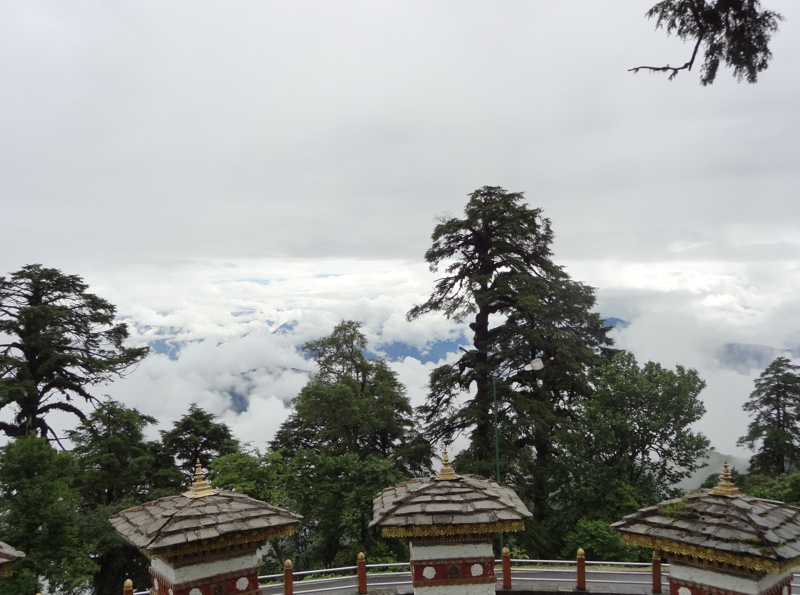
walked along a very muddy path in the rice fields. When we got to the temple, we heard something that sounded like a 5th grade band concert coming from across the lawn. Apparently this temple is also a school for young monks, and they were learning to play some ceremonial instruments. With that in the background, we walked around the temple learning more about the paintings and stories inside.
After the tour, we met Tenzin at the bottom of the hill and headed into Punakha for lunch. It was yet another tourist restaurant, with much the same food as before. After lunch, we headed north from Punakha to the place where two rivers (a male and a female river, apparently) converge to form the river that runs through Punakha. At this convergence is built one of the largest dzongs in the country, the "Castle of Great Happiness." The Monastic Body spends their winters here to escape from the cold of Thimphu, and it used to be the main administrative building when Punakha was the capital. Tandin and I walked through this temple, which has three courtyards surrounding a temple similar to that in Thimphu. One thing that's different is the temple's back wall, which has a detailed history of Buddha's life, from his birth to his enlightenment to his death. It has a striking resemblance to the story of Christ in Christianity. At end the tour, I was allowed to climb up about six stories to the top of the central tower of the dzong. On each floor there was a different temple, and I met several monks going up and down performing the daily water offerings.
After the dzong, Tandin and I took a short walk to Bhutan's longest suspension bridge. I expected this to be a bridge for cars, but it was a narrow walkway spanning the "male" river. The view was outstanding and there was a breeze blowing through the prayer flags that made it picturesque. I walked from one end to the other, envying the little
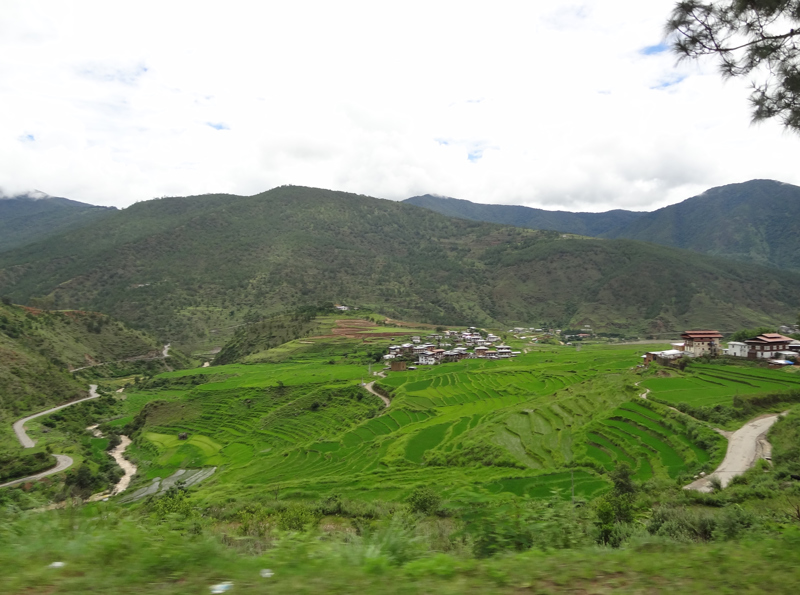
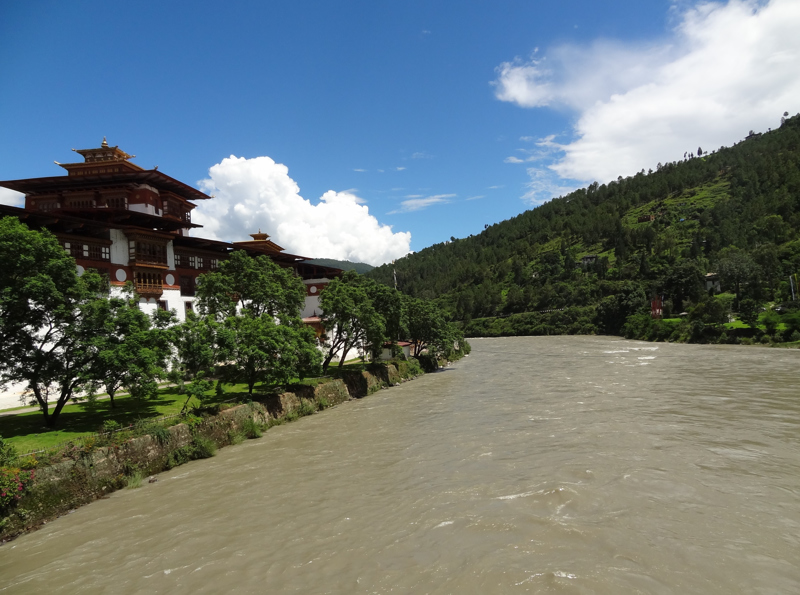
boys who had found a patch of mud to play in on the riverbank below. I suggested to Tandin that we join them but I was out of luck as he doesn't know how to swim.
After walking back to the car, Tandin bowed out due to a head cold and Tenzin and I went on the afternoon hike. This walk is one of my top two memories from Bhutan. Tenzin isn't quite as comfortable with English, so there was less talking than normal. However, he led me at a good pace along a path through rice paddies, patiently waiting while I stopped to gawk at the oxen plowing the fields and the women dong the planting. It is warm enough in this valley to get two crops of rice each year, so they were busy with the second seeding. We were walking between two rice paddies, and I wished I could take off my shoes and squish through the mud with them for a day to see what it was like. I was fascinated watching the men drive the oxen,
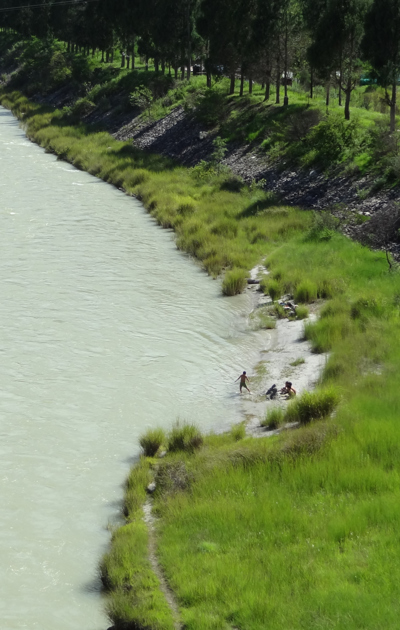
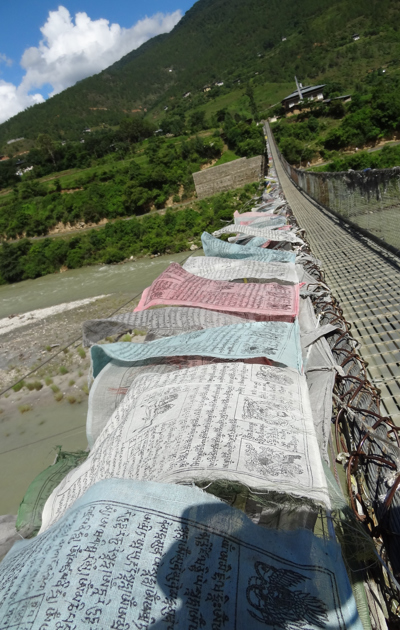
something I had never seen before. Tenzin had spent a month working on a rice farm, and he was able to answer my questions as they came up. After a quick break at a prayer wheel half way up, we went forward at Tenzin pace (read...quickly) to the stupa at the top. This stupa was interesting because it had three floors, each with a temple to visit. The third floor had a deck where we stood for a while admiring the view. I couldn't capture the impressiveness of the view with my camera, and I certainly won't be able to do it with words, but it was breath-taking. The valley disappeared off to the left and right, with every possible color of green. This is one of the few examples I can recall where the interference of man with nature made it more beautiful. The rice paddies and small villages dotting the valley added to the effect, giving an impression of fruitful work and harmony with the land. All this was magnified by the vast scale of view. It was a good 10 minutes before I could convince myself to go back down the stupa, then down the trail to the car. The car was parked right next to
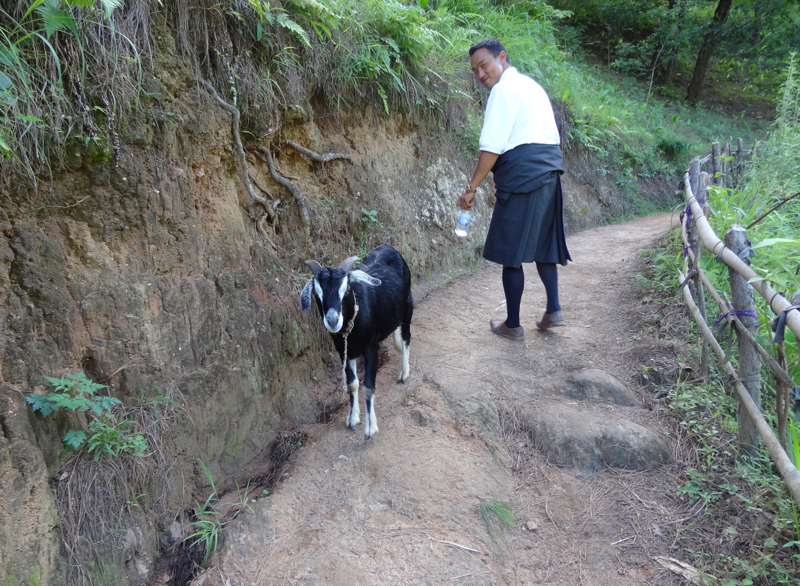

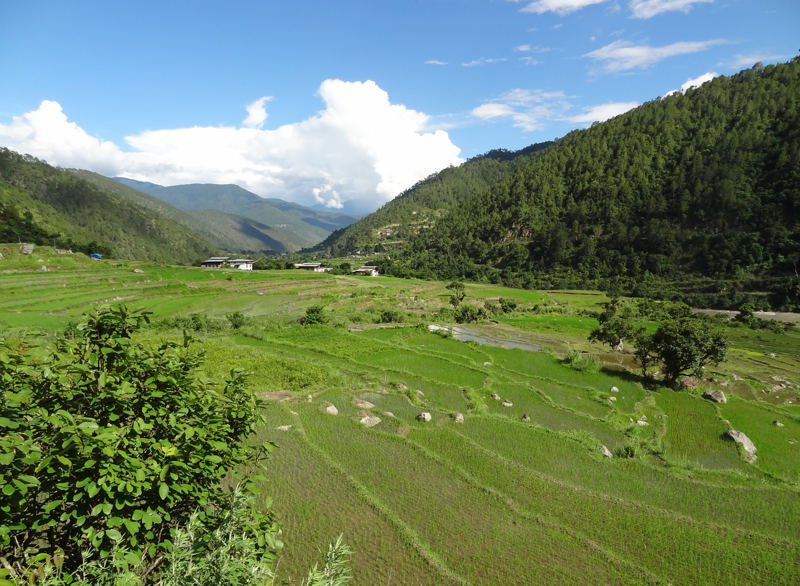
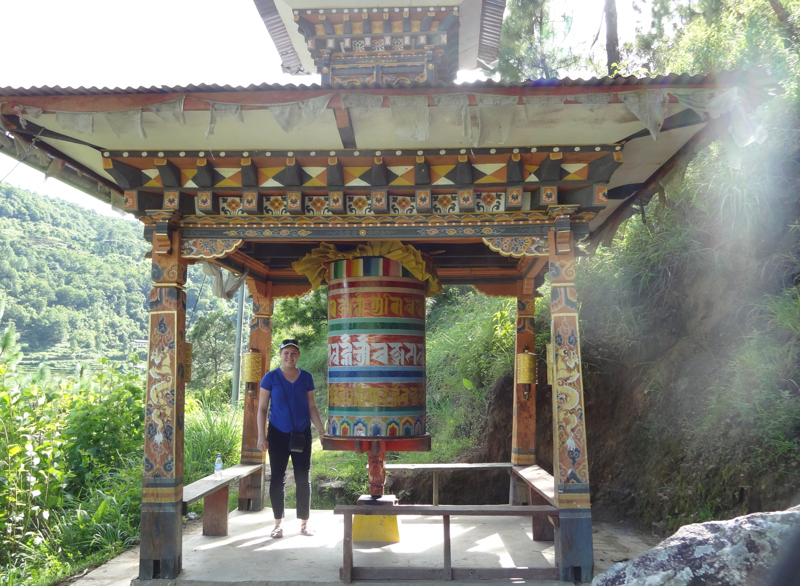
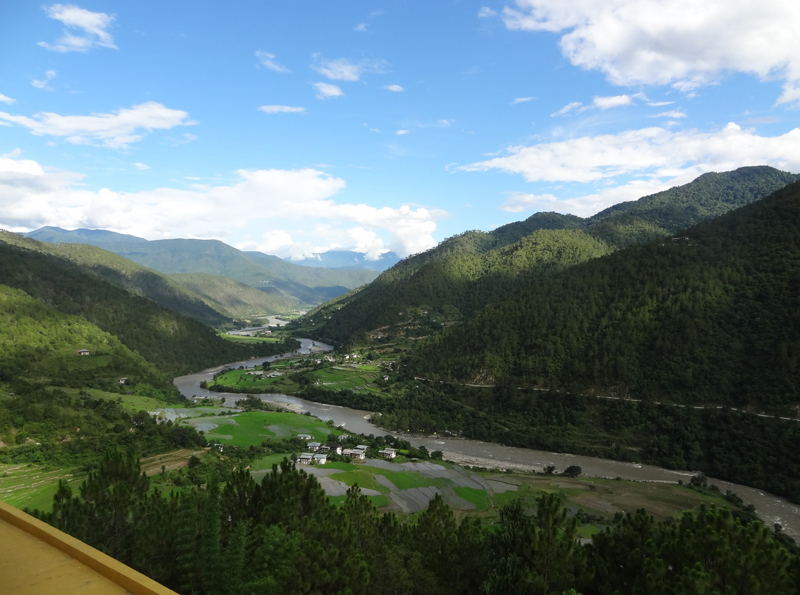
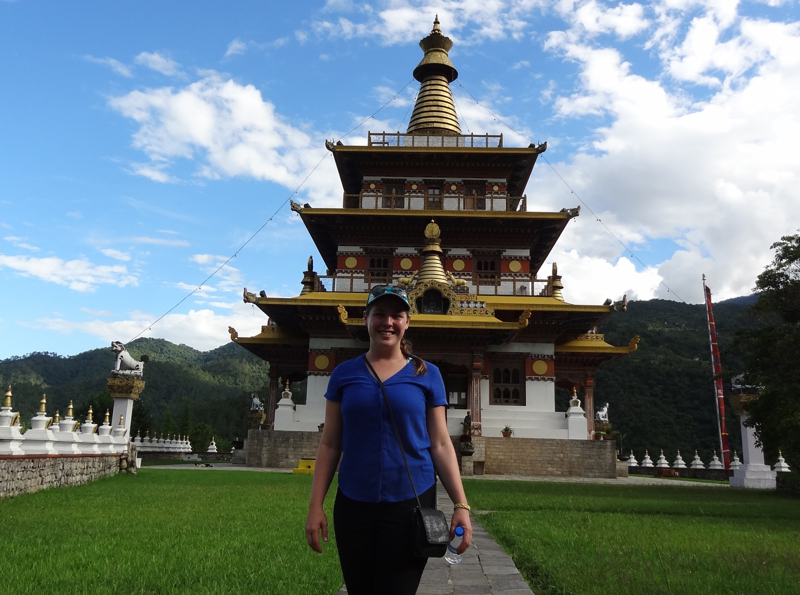
the river, so I went down to a little beach to splash around and clean off my shoes before we headed back to town. The water was FREEZING!! I was no longer so envious of the little boys we had seen playing in the water earlier.
Our next stop was the tiny town of Punakha. My hotel was pretty far away, so Tandin and Tenzin waited in the car while I wandered around a bit. This was nice of them, as it was already past their unofficial quitting time. I had decided during the morning car ride that I wanted to get each of them presents at the end of the trip. I had learned that Tandin had a new baby and a little girl that loves singing the Let it Go song from Frozen. I had come up with the idea to get Tenzin some tools as a gag gift so that he could fix the car the next time that it broke down. With this goal, I started walking the four blocks in town, coming out with a Frozen dress for Chanu, Tenzin's daughter, and some tools for Tenzin. I certainly got a look when I went to the register with a crescent wrench and a pair of pliers! Another fond memory from this shopping trip: I was walking along the street and passed three little kids going the other way. They were maybe 3-5 years old, and once I had passed, I heard them giggling and chatting. Finally, all three of them at the same time yelled, "HELLO!!" at the top of their voices. I turned back and said hello in return, thinking that kids are probably the best people in any culture. After shopping I was taken to my hotel for the night, which was a
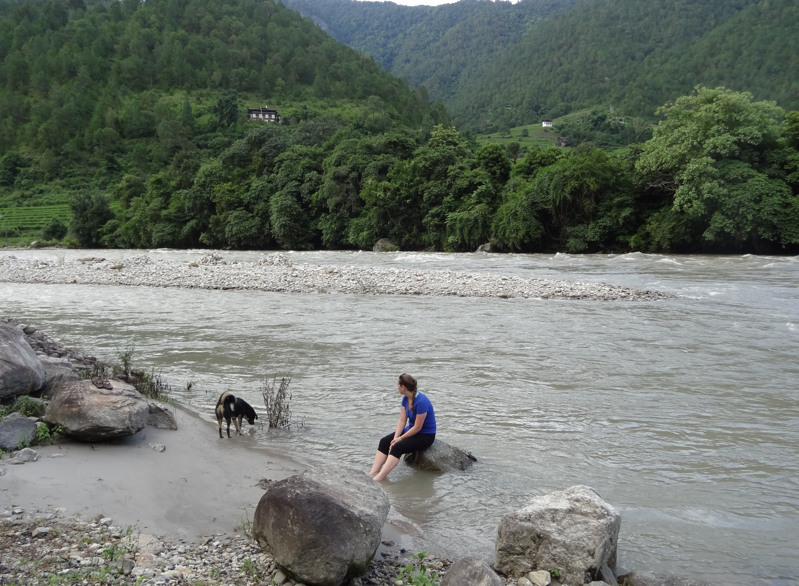
beautiful retreat up a hill with a view of the valley. There was Wi-Fi in a common gazebo, so I caught up with the notifications on my phone from the past three days while chatting with some Australians who had been drinking vodka in that gazebo for several hours. I went into dinner at the hotel (more of the same), where I made friends with a waitress who had just finished high school and lived nearby. She asked whether I was married and thought it better that I wasn't. After dinner, I took a beer out to the gazebo and continued sorting through emails. Bhutan has a brand of beer, Druk, which comes in three varieties- Lager and Premium are lighter beers and the heavier one, which almost tastes like liquor, is Druk 11000. They weren't bad for such a small scale production! Before I had finished my beer, Tandin and Tenzin came walking back into the hotel. Apparently they were sleeping in the guide house at this hotel, so Tandin sat down to drink a beer with me. They were going out soon, and invited me to come with them! I was pretty excited to see the night life with some locals, so I changed out of my sweaty clothes and we hit the town.
This was my other favorite memory in Bhutan. Tenzin doesn't drink, so Tandin and I had a professional driver for our designated driver. Tandin had no such scruples, and before long he was leading us to what I would call a Bhutanese dance club, I guess. It was something that I have not seen anywhere else in the world. The club was set up with rows of seats and tables facing a stage and emcee's table. There were maybe a couple dozen 20-something girls walking around in their traditional dress and holding little notebooks. If you liked the look of a dancer, you could pledge a sum of money for them to dance to a song of your choice on stage. I suppose this has similarities to a strip club, but the only skin showing was their faces and necks, hands, and the tops of their feet in sandals. The dances were more risqué than traditional Bhutanese dances, but none of these girl had ever heard of twerking. Not that you could see much if they did in their long skirts. It was such a wholesome way of reinventing the gogo dancer and made me very happy for their country. Tenzin was friends with one of the dancers, who had been married very young and had a child, but was now divorced and supporting herself through dancing. I contributed to her dance book but let her pick whatever song she liked, which turned out to be a karaoke duet- more singing than dancing. I thought she was the prettiest dancer there, but it didn't look like her heart was in it- more of a job than a passion. Anyway, we stayed here for a couple of hours, Tandin and I drinking beer and Tenzin refilling our cups when they were empty. The best song of the night was "The Drunk Nepali" performed by a hilarious Bhutanese guy. I didn't need to know Dzongka to understand the thesis- some drunk guy was coming home for the night and his wife wouldn't let him in. It was sooo well performed- I wanted to go up on stage and tuck some money into the belt of his goh...
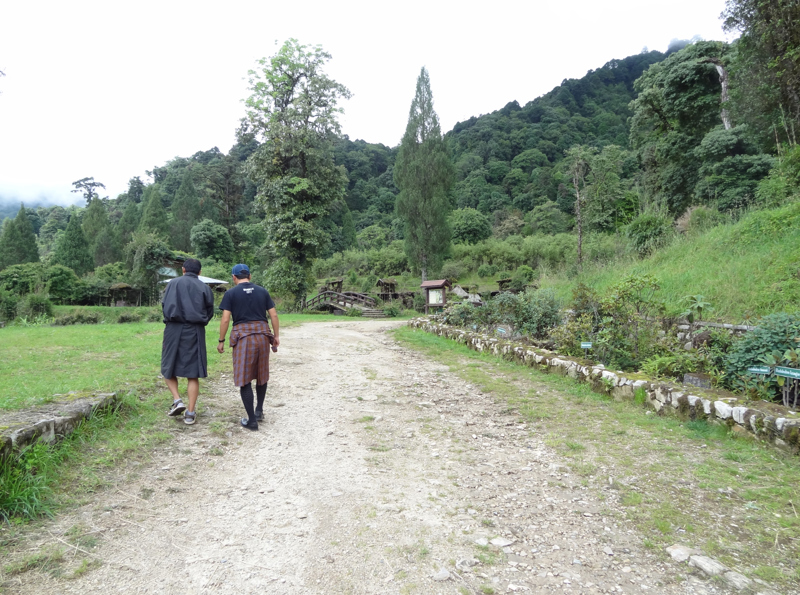
Eventually it was time to go home, which was a good idea given our early start in the morning. After eating breakfast in the gazebo overlooking the valley, we loaded up in the car to retrace our steps back over the pass, past Thimphu, and to Paro. This drive was much the same as the day before, only there were fewer points for Tandin to show me on the way up. We did stop at the Royal Botanical (Bhutanical??? Anyone???) Park to walk around a bit. This is a national park with an information center about the biodiversity in Bhutan. Tenzin watched the movie with me, then we walked around the rest of the exhibits and the park outside. A short time later we were back in the car and Tenzin put in a shuffle of Bhutanese music. It was truly a mix- there was everything from prayer chants to traditional songs to songs from the dance club the night before. As we reached the top of the pass, what should come up but some Green Day!! Never in my wildest dreams did I think that I would be climbing a mountain in Bhutan in a Toyota, singing along to teenage angst music! They couldn't understand why I was laughing. We stopped at a hotel on the pass, and I was allowed to sit with the guides to drink my tea, instead of by myself in the dining room...promotion! I spent the time showing Tenzin pictures from my home and the various places I'd traveled in the US. The rest of the drive passed uneventfully, with the exception of stopping to buy yak's cheese! In hindsight, I'm not sure I would call it cheese. It's more like a cheese-flavored rock that you gnaw on until you break it into chunks that can be pummeled into submission. It took me a full 30 minutes to eat a piece that was half an inch square. Nature's jawbreaker!
The first stop in Paro was lunch at another tourist restaurant. After that, we visited the Paro Rimpung Dzong, which was built in the 17th century. It was similar to the other temples that we had seen and I was able to guess the significance of many of the paintings as we went through. We did get to see the Buddhist circle of life, which represents 3 heavens and 3 hells. People between the six realities from one life to the next based on their karma from good and bad deeds. All sentient beings must face the Lord of the Dead when they die, and he weighs the good deeds (white stones) against the bad deeds (black stones) to determine where they will go in the next life. We finished up at the temple and walked back to the main part of town where Tenzin was waiting for us. I had a little bit of time to shop around, and Tenzin came with me for the walk. I told him we were on a mission to find something for Tandin's new son, and in an hour we had his first soccer ball (very squishy). Tenzin volunteered to hide it in the pouch-like pocket in his goh until I could stash it in my bag. From there, we drove to a vacant archery field and I received my first lesson in traditional Bhutanese archery! The bow is just two pieces of curved bamboo tied together, which are bent when the bow
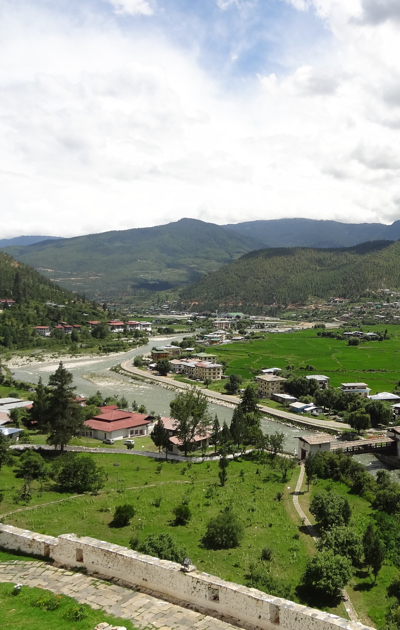
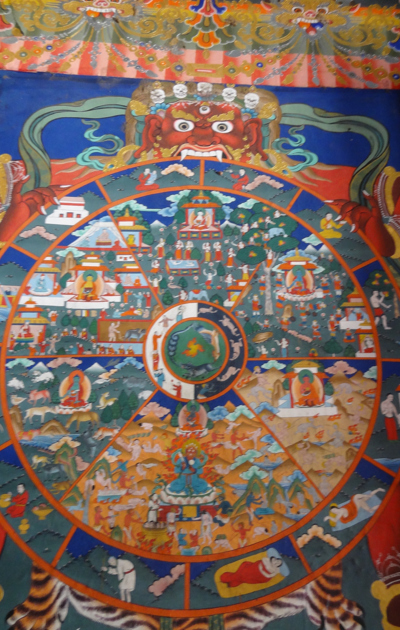
is strung. Tandin taught me the basics, and while there were a couple of wild shots, I didn't lose any arrows! I started at maybe 30 meters, but kept getting closer as I failed to hit the target. Eventually I got Tandin and Tenzin in on it- they each got one arrow and I got four each round- trying to hit the target. Finally, when we were maybe 15-20 meters away, they hit the target in succession. Both of them stuck the arrowhead so hard in the wooden target that Tenzin had to work for 5 minutes to dig them out. The next round I also got one to stick! We decided to end on a good note.
The rest of the day was dedicated to my farm stay. I was very excited for this coming into Bhutan, and hoped that it would give me a chance to see exactly how much farming differed from country to country. When we first arrived at the farm house, the only person home was the old grandma- maybe in her mid-60's. She didn't speak
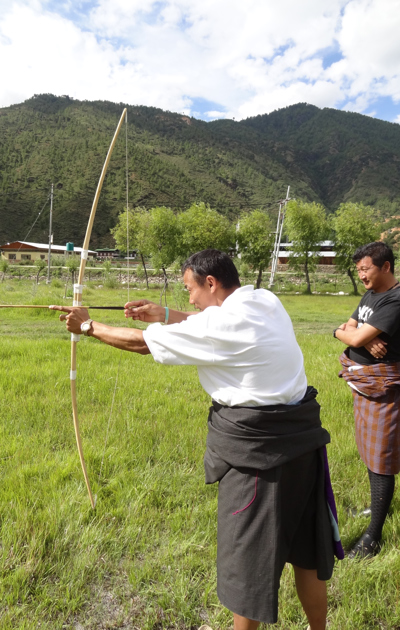
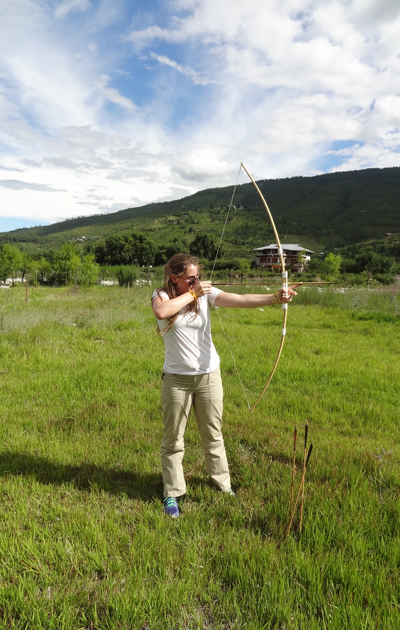
any English, but Tandin spoke to her in Dzongka and she gave me a couple of friendly, toothless smiles. The house was 2.5 stories tall, with a ground floor rented out to tenants and an attic for storage. The family lived on the second floor, which had a kitchen connected to a living/ dining room, two bedrooms for family, one bedroom and sitting room for guests, and a large alter room. I had the guest bedroom and sitting room to myself, and was allowed to look in on the alter room, which was bigger and more intricate than any other part of the house. The kitchen had a gas stove (including propane tank) with two burners. There were pots and pans hanging on the walls and other dishes stored in the kitchen. Food was stored elsewhere (maybe downstairs) and the room off the kitchen seemed to be where the family spent most of their time. The bathroom consisted of a squat toilet off the front porch with no sign of a shower. No one else would be home for 2-3 hours, so Tandin and Tenzin left and I went out for a walk. I started by going to the river
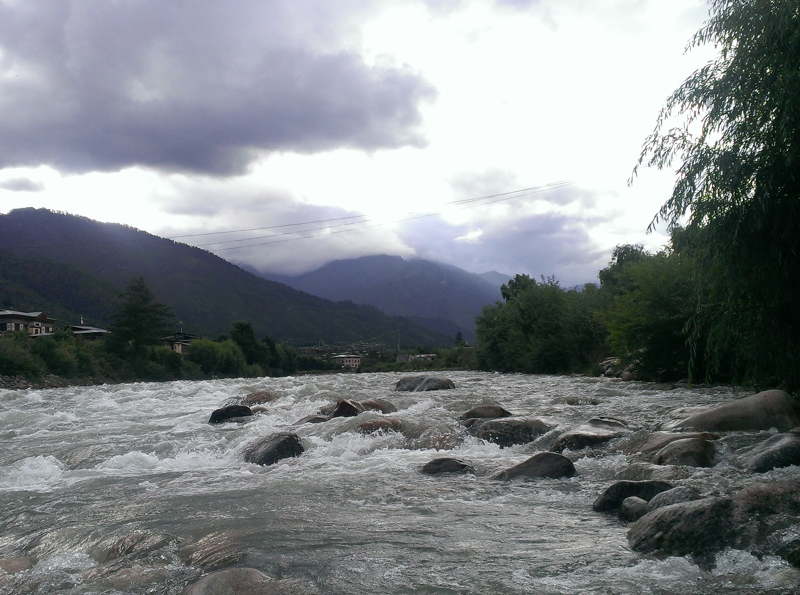
and sitting on a rock in the middle of the stream. When I turned to leave, I saw two boys had climbed halfway out to my rock and were staring at me. I smiled and them and walked back out to the bank to suggest that we see who could throw a rock the farthest across the river. Bhutanese kids have all their classes in English, so they were able to understand and answer me without any problem. After our competition (I won!), we walked together for a bit- they wanted to know how much an expensive car costs in America and I wanted to know what sports they played. They also wanted to know where I was going, and I didn't have much of an answer. After they turned to go home, I strolled along the main road, catching a very large number of stares along the way. After a while I walked back along the road to the farm house. The grandma was watching Bhutanese Idol (which only allows housewives as competitors), so I went in and watched with her until someone else arrived home.
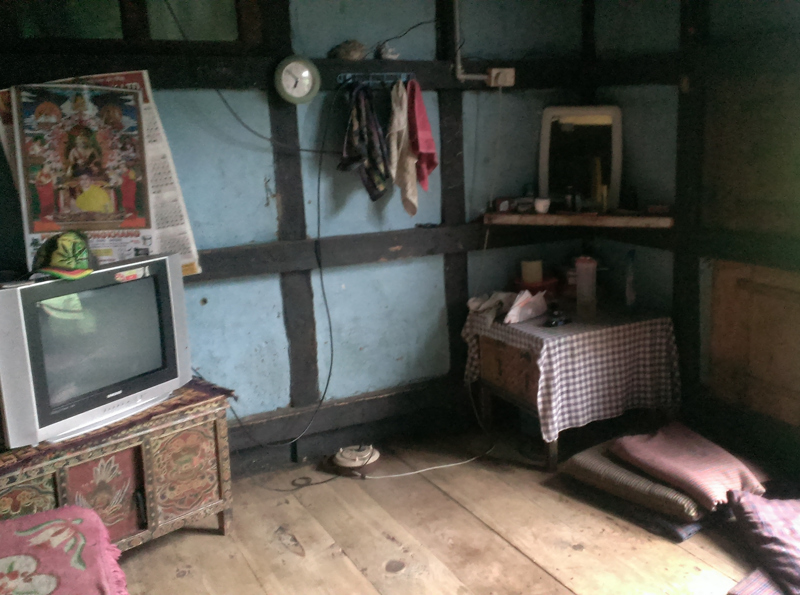
Very soon, her son-in-law arrived home. He ran a shop nearby where the family sells some of their garden products. I was a little disappointed to learn that the family rented out its farm ground and was no longer very involved in the production of rice. After I learned that, I treated the night as a homestay, and I think it was very successful to that end. My host had been a chef in the tourist industry for 20 years, and set to cooking dinner. In the meantime, his 14 or 15 year old son came home, and I enjoyed watching the family's interactions, even if I could not understand the words. We continued to watch Bhutanese Idol, with additional context given by my host. Before dinner, they also gave me some traditional Bhutanese liquor. They make it themselves out of wheat- fermented for about 30 days. To prepare the drink, they heat butter very hot in a pot, then add an egg and fry it. Once it is fried, they scramble it with a fork and add the liquor. The warm drink tastes like a very weak scotch with pieces
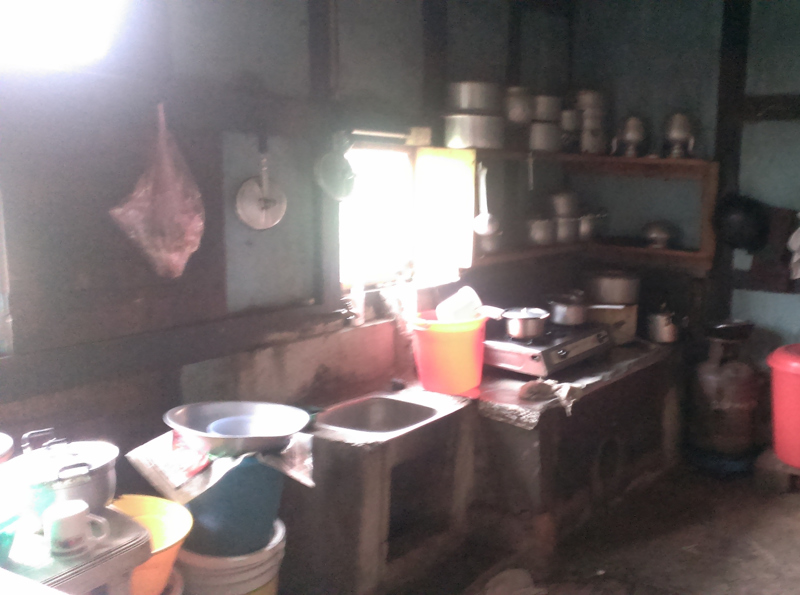
of egg in it. I had the hardest time getting the egg out of the little cup, and was sure by the end that beer is the better option. Finally it was time for dinner, which we ate in the traditional way, sitting criss-cross applesauce on mats on the floor. I'm not particularly good at sitting cross-legged, and by the end of dinner both of my feet were numb. They also do not use silverware, but eat with their hands. This went well at first, but by then end my lap was covered with rice kernels. I'd say it was harder than chopsticks. After that, they sat around watching TV much in the way that we do at home. Around 10 p.m., it was time for bed and I retired to my large bedroom to get comfortable on the mattress on the floor.
My last day, 7/13, started bright and early with my host bringing me milk tea at 6:30 a.m. An hour later, we had fried rice and egg for breakfast, Tandin demonstrating his impeccable timing by showing up just when the food came out of the kitchen. After that, it was time to say goodbye to the farm house and head to the Tiger's Nest for my final hike. This monastery perched on the side of a cliff is probably the most famous landmark in Bhutan. It is called the Tiger's Nest because a saint is said to have flown to Bhutan on the back of a tigress and landed in this very spot. The hike up to the monastery is a 900 meter change in the elevation, and many people choose to do it on horseback rather than on foot. Tandin has made the walk around 200 times, so it is no big deal for him. Tenzin dropped us off a little after 8:00 a.m., and we started on the heels of a couple other tourists. I was surprised at how hard the climb was for me. Tandin was going along like he was on a Sunday stroll, and I was sucking air like I'd just been tackled and had all the wind knocked out of me! I suppose it was the elevation- I wasn't all that tired, but I could not catch my breath. I would walk for 2-3 minutes, then stop and breathe for a minute, and continue the process all the way up. It took us about 1.5 hours (including a small stop at the half-way point) to reach the
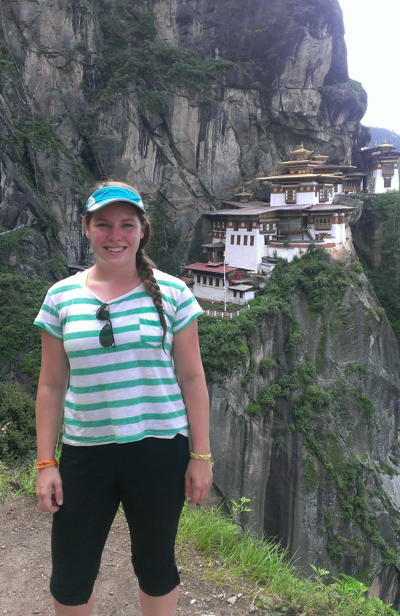
waterfall, which is just 700 stairs away from the monastery. He said his record was 45 minutes with a couple of Swiss tourists. Regardless, I was still the first tourist of the day! I beat the horses, at least! The structure itself was cool, but much like the other temples that we had visited. Two things stick out in my memory. I finally got to see a monk ritual. There was an important day coming up, and the monks were preparing by performing a ceremony for a week or so in advance. They basically all sat around one of the temples and chanted a mantra repeatedly. One cool thing about this monastery is that the offerings were not just money, but also snacks of all kinds, including beer and choco-pies. Food made as an offering is said to be blessed, and the snacks are eventually distributed to the people. The other unique part of this temple was a little opening in the floor where you could crawl down rocks and ladders into a cave that was the official "Tiger's Nest", or the place where the tiger had landed in the legend. I
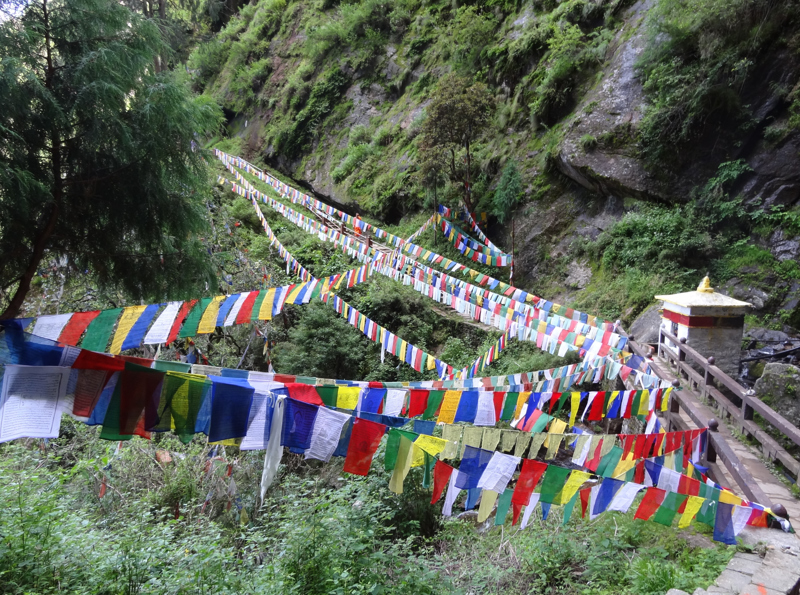
crawled to the bottom and saw a small alter set up at the back of the cave. After that, it was time to go back to down the mountain. We did this very quickly, and I made up for the talking that I couldn't do on the way up for lack of breath. Around 11:30 a.m., we reached the bottom of the mountain and climbed back into a newly washed car.
I had begged Tandin to let me shower before we did anything else and checked into my hotel, which was beautiful. It was the first luxury hotel constructed in Bhutan, and was commissioned for the use of international VIPs attending the coronation of the fourth king in the 70's. It was again set up on a hill and the lack of other tourists meant I was given a nice room overlooking the river. After a quick shower, they picked me up and helped me put on my kira (traditional Bhutanese skirt). I figured this was my last chance to wear it, so I kept it on for a couple of hours that afternoon. We went to lunch at a local restaurant (finally!) and ate momos. Momo is their word for
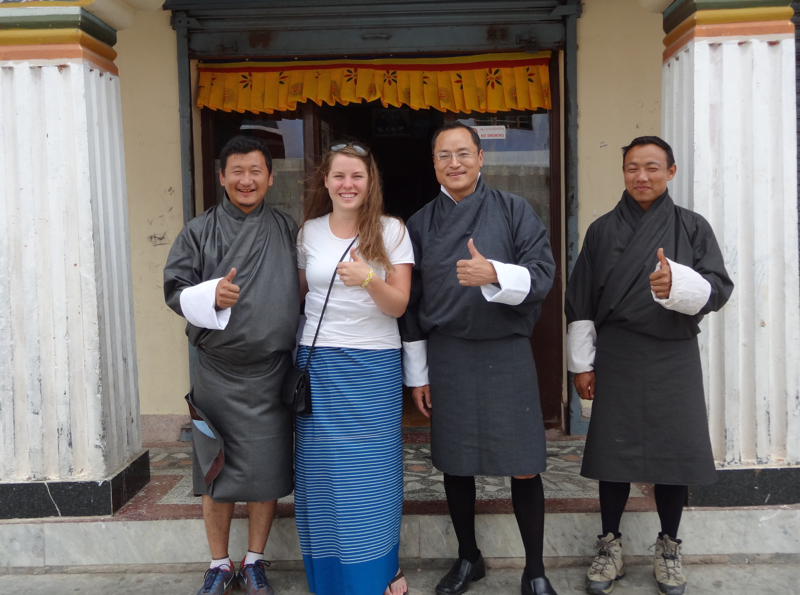
dumpling, which they dip in chili sauce and eat with their hands. We were met there by Tshering, who is the head of the operation. He told me a little more about the company, their values, and solicited some feedback from my experience. He also gave me an awesome drawstring bag decorated as the Bhutanese flag as a souvenir. After that, Tenzin drove us to the very last tourist attraction- the National Museum. This was actually cooler than I was expecting. The first couple of exhibits were more of the same stuff we had seen before- ceremonial masks and paintings of deities, etc. But then we got into a couple of rooms that had pelts and pictures of the wildlife in Bhutan. You could see this is what interested Tandin most. I learned a ton about the different animals and where he has seen them in Bhutan.
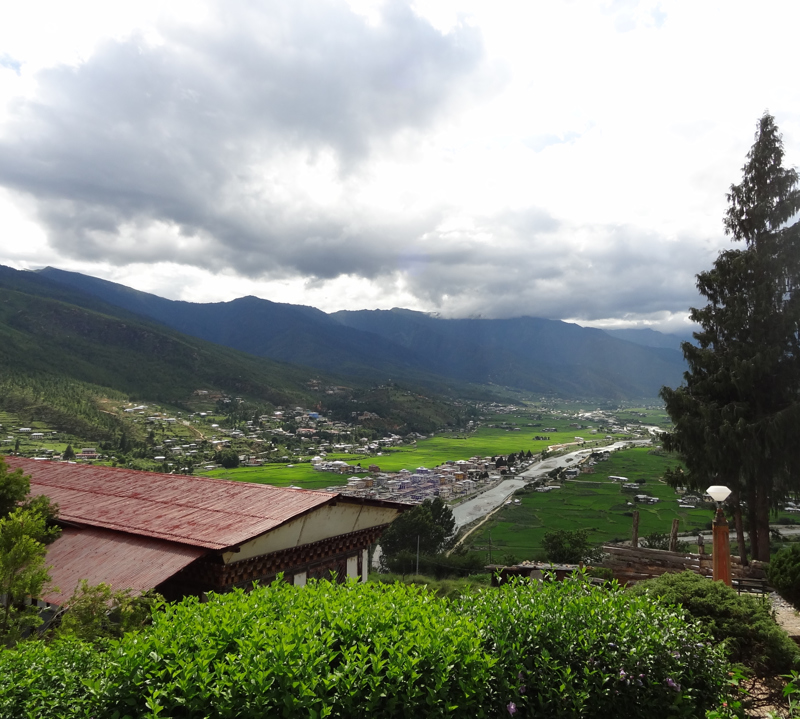
He has been guiding tours for the last 15 years (he's 36) and has been to almost every last part of his country. There were only one or two things he had never seen in the wild- like the tigers roaming certain the forests. We spent 20-30 minutes going over the various pictures and he told stories about many of them, using some seriously impressive English vocab words.
After this last excursion, we went back into town so I could do my final shopping. I finally had an idea for a gift for Tandin, but it was going to be hard to execute. When we went out in Punakha, I had asked if there were any Bhutanese drinking games, and he said there were not. He hadn't even heard of beer pong! I thought this was a shame for someone who was clearly an enthusiastic drinker, so I was going to find some ping pong balls and disposable cups for him. Easier said than done... Bhutan prides itself on being carbon neutral, and it is NOT easy to find disposable anything. I think I went through every shop in Paro, but I eventually found them. There were only 18 in the store, though, so I was 4 short of a complete set. After this, they dropped me off at the hotel for a couple of hours, where I took care of logistics around my next hostel, laundry, and getting their thank you notes and tips arranged. They came to pick me up around 7:30 p.m., and it was off to the final dinner. We went to a local place (all three meals today, if you're keeping track), and Tenzin explained the menu to me while Tandin went across the street to pick up his daughter, who was with some relatives. Chanu was a cute little girl who shared the tendencies of most 2-3 year olds to love apple juice and Frozen and to be shy around strangers. She didn't take to the dress right away (although I'm told that she did when she was home), but she did chase the little soccer ball all around the restaurant. We had some peanut masala, which was a spicy take on bar peanuts, then a real Bhutanese meal full of rice, chilis, and smoked ham. I thought it was good and was a little surprised it wasn't spicier.... I think Tandin might have managed it that way. After we ate, Chanu wanted to go home, so we loaded up and headed back to the hotel. Tandin and Chanu walked me back to my room, and I got a little hug from her before she left for the night. I finished up packing to be ready to go bright and early in the morning.
At 6:00 a.m. the next morning I loaded up into the Toyota for the last time. It was a quick drive to the airport, then a sad goodbye with my new friends. Both of them had made me feel like I wasn't traveling alone, which made my time in Bhutan much more special. I had as much getting to know them as seeing the temples and dzongs. One short goodbye later, I was on my own again waiting for a flight to Kathmandu. I had a 6 hour layover there, most of which was spent outside of check-in without A/C, then a quick 2 hour ride to Delhi. My stay there was considerably nicer, as I was able to get into the Singapore Airlines club and eat all sorts of great food for free. After 7 hours of layover there, my flight left at 1:00 a.m. to take me to Zurich, where I would arrive around 7:00 a.m. to start the final chapter of my adventure!
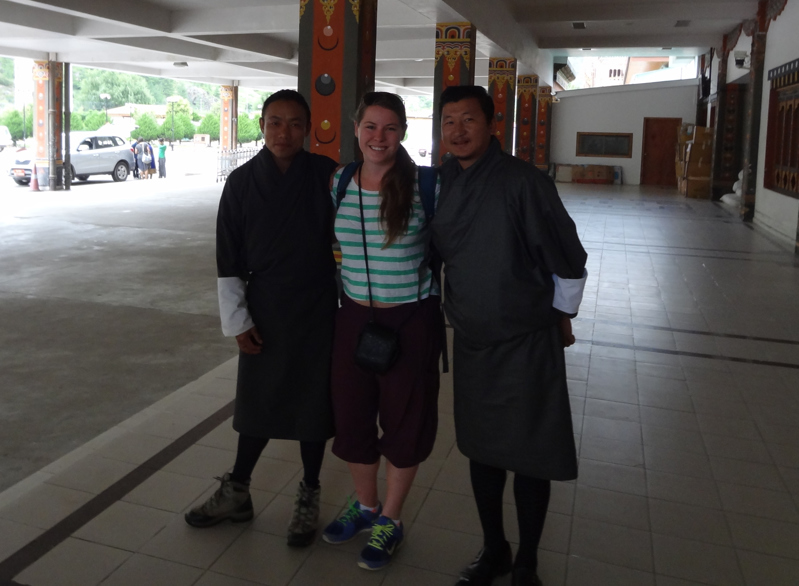
Share your travel adventures like this!
Create your own travel blog in one step
Share with friends and family to follow your journey
Easy set up, no technical knowledge needed and unlimited storage!